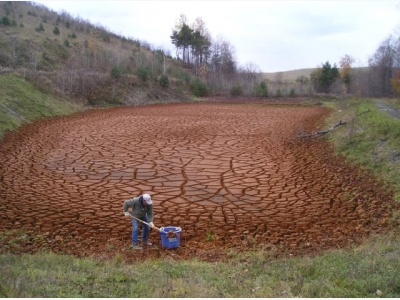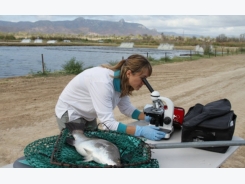Mine over matter

A cheap and plentiful by-product from the coal mining industry could dramatically improve the quality of water being released by land-based aquaculture facilities.
Mine drainage ochres are plentiful, economical and highly effective at removing phosphorous from waster water systems.
An engineering team at the US Geological Survey (USGS) has discovered that discarded mining by-products, called mine drainage ochre, can be used as the primary filtering agent to remove phosphorous (P) from aquaculture waste waters and have included this cost-effective and environmentally friendly water filter system into the trout broodstock facility at the Leetown Science Center.
“It’s much more efficient,” explains Phil Sibrell, who heads the USGS team involved in developing the project, “than alternative materials used in fixed bed filters. In most cases, a contact time of 10 minutes or less will be sufficient to remove P from the water.”
The ochre used is crushed to form a porous granular medium in the Leetown filter system, which holds around six hundred pounds (272 kg) of the by-product and is fitted with a gravity flow process in which the water is piped to the top of the tank, allowing it to pass through the media, before being released, without phosphorous, out of the bottom of the tank. The wastewater is then sent to a settling pond, then passed through a UV treatment before being released to the watershed.
Recycling at its best
As well as being economical, another key advantage of using the ochre is, according to Phil, that the phosphorous it removes from the water can be reused.
“When we need to regenerate the media we can strip the phosphorous off and then precipitate it. It can then either be used as a garden fertiliser, similar to bonemeal, or fed into the commercial production of phosphate fertilizers,” Phil points out. “This allow us to close the recycling loop, by reusing both the ochre and phosphorus again.”
The ochre-based filter was originally used by the team in table-top water filters, but in the course of the last five years they’ve managed to upscale it considerably.
“The Leetown system treats 100,000 gallons of water from the broodstock facility each day – that’s roughly 70 gallons a minute,” Phil points out.
“It’s not a huge volume when compared to some flow-through aquaculture projects,” he concedes, “and if we were to increase the scale we would have to think about equipment. But it’s perfect for recirculation aquaculture systems (RASs).”
The US Department of Agriculture broodstock RAS co-located at the Leetown Science Center has the capacity to hold 4,000 kg of rainbow trout broodstock – roughly 20,000 fish in all – and Phil is impressed by the efficiency of the ochre at removing the phosphorous, while he adds that it can be paired with other systems to remove other key waste materials.
“The ochre doesn’t pick up nitrate but it can be paired with denitrification systems to do this,” he points out.
The USGS team is now investigating the potential to commercialise their system.
“We’ve got two patents for the technology,” says Phil, “and we’re now looking to pursue a commercial agreement to work with on the licencing and the commercial development process. I think that the aquaculture sector is where we’ll be doing our initial work, as it would be an easy adaptation for us.”

A selection of mine drainage ochres © USGS
“As well as at Leetown, we’re already worked on this with the US Fish & Wildlife Service in Pennsylvania,” he adds.
Addressing Harmful Algal Blooms (HABs)
Purifying the water in land-based farms to ensure the fish remain healthy isn’t the only way the aquaculture industry – or the wider aquatic environment – could benefit from the technology, however, as more efficient removal of the phosphorous from municipal water treatment plants or field drains, for example, could also help to improve the water quality of both seas and lakes.
Indeed, dietary phosphorous that’s excreted into waste water can accumulate and feed cyanobacteria, spawning harmful algal blooms (HABs), which can create hypoxic dead zones responsible for fish kills and shellfish deaths.
“Harmful algal blooms are a huge problem across the world – for example in Chesapeake Bay and Lake Okeechobee in the US, and in the Baltic Sea, over in Europe,” Phil continues. “Since phosphorous is one of the main drivers for these blooms, being able to remove it from waste water has some real promise for being able to reduce their ecological impacts. Removing the phosphorous is like removing the fuel from a fire.”
As a result, he is also looking to use the ochre-based system to remove the phosphorous from municipal waste water.
“We are at the point now where this filter system could support a small town, maybe around 1,000 people,” Sibrell said. “Finding co-operators willing to work with us and incorporate this technology will allow the system to continue to grow in size and improve over time.”
The simple design of the filter, and the use of a by-product as a filtering agent, keeps the costs down for any water treatment facility that considers using this technology.
“Every component of the water treatment system was purchased as commercial, off-the-shelf items,” Sibrell said. “Nothing was special ordered and nothing was custom fabricated, which really helped us keep the costs down.”

USGS engineer Phil Sibrell leads the project
Further benefits
The USGS phosphorous filter also has the added bonus of addressing the serious problem of acid mine drainage.
This occurs when certain minerals – like pyrite or other sulphides – are exposed to air and moisture by mining or excavation. When this happens, it causes a chemical reaction in the minerals that creates sulphuric acid and a variety of dissolved metals. This acidic, heavy metal-laced water eventually makes it into local watersheds, altering water pH and introducing new contaminants to ecosystems.
Treatment of the mine drainage wastewater produces the ochre. Creating a value-added product out of this will help bring in income to offset mine drainage treatment costs, and allow for more widespread remediation of coal mining impacted waters.
“Using the ochre is a win-win process, as it kills two birds with one stone,” Phil enthuses. “So it’s a really attractive option.”
Recognition
The team recently entered stage one of the George Barley Water Prize contest, an innovation challenge competition sponsored by the Everglades Foundation, for the development of technology to remove phosphorus from waste water and agricultural runoff. Out of over 180 initial entries from around the world, the USGS technology placed in the top five for the first stage of the competition. The team is making preparations to participate in stage two of the competition, which is a laboratory demonstration of the technology and will take place this fall.
“It’s been a great showcase for our technology,” Phil reflects, “and shows that it stands up to outside assessment.”
Có thể bạn quan tâm
Phần mềm

Phối trộn thức ăn chăn nuôi

Pha dung dịch thủy canh

Định mức cho tôm ăn

Phối trộn phân bón NPK

Xác định tỷ lệ tôm sống

Chuyển đổi đơn vị phân bón

Xác định công suất sục khí

Chuyển đổi đơn vị tôm

Tính diện tích nhà kính

Tính thể tích ao hồ



 How mussel farms can boost biodiversity
How mussel farms can boost biodiversity  Environmental DNA sampling shows huge potential for aquaculture
Environmental DNA sampling shows huge potential for aquaculture